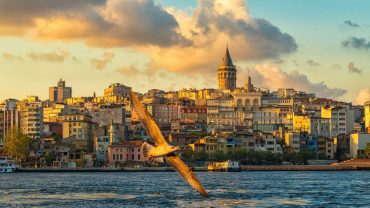Hatay Province (Turkish: Hatay ili, pronounced [ˈhataj]) is Turkey’s southernmost province. Almost all of it is located outside Anatolia, on the eastern coast of the Levantine Sea. The administrative capital is Antakya (Antioch), and the port city of İskenderun (Alexandretta). It is bordered by Syria to the south and east and the Turkish provinces of Adana and Osmaniye to the north. The province is part of Çukurova (Cilicia), a geographical, economical and cultural region that covers the provinces of Mersin, Adana, Osmaniye, and Hatay. There are border crossing points with Syria in the district of Yayladağı and at Cilvegözü in the district of Reyhanlı.
Sovereignty over the province remains disputed with neighbouring Syria, which claims that the province that had an Arab majority was separated from itself against the stipulations of the French Mandate of Syria in the years following Syria’s occupation by France after World War I. Although the two countries have remained generally peaceful in their dispute over the territory, Syria has never formally renounced its claims to it and still shows it within its border in official maps.
History
Settled since the early Bronze Age, Hatay was once part of the Akkadian Empire, then of the Amorite Kingdom of Yamhad. Later, it became part of the Kingdom of Mitanni, then the area was ruled by a succession of Hittites and Neo-Hittite peoples that later gave the modern province of Hatay its name.
The Neo-Hittite kingdom of Palistin was also located here.
The area came under the control of Assyrians (except for a brief occupation by Urartu), and later the Neo-Babylonians and the Persians.
The region was the center of the Hellenistic Seleucid empire, home to the four Greek cities of the Syrian tetrapolis (Antioch, Seleucia Pieria, Apamea, and Laodicea). From 64 BC onwards the city of Antioch became an important regional centre of the Roman Empire.
Among the famous archaeological sites in the province are Alalakh, Tell Tayinat, Tell Judaidah, and Antioch.
Medieval era
The area was conquered by the Rashidun Caliphate in 638 and later it came under the control of the Ummayad and Abbasid Arab dynasties. From the 11th century onwards, the region was controlled by the Aleppo-based Hamdanids after a brief rule of Ikhshidids. In 969 the city of Antioch was recaptured by the Byzantine Empire. It was conquered by Philaretos Brachamios, a Byzantine general in 1078. He founded a principality from Antioch to Edessa. It was captured by Suleiman I, who was Sultan of Rum (ruler of Anatolian Seljuks), in 1084. It passed to Tutush I, Sultan of Aleppo (ruler of Syria Seljuks), in 1086. Seljuk rule lasted 14 years until Hatay’s capture by the Crusaders in 1098, when parts of it became the centre of the Principality of Antioch. At the same time, much of Hatay was part of the Armenian Kingdom of Cilicia, who subsequently allied with the Mongols and took control of the Principality of Antioch in 1254. Hatay was captured from the Mongol-Armenian alliance by the Mameluks in 1268, who subsequently lost it to Timur (Tamerlane) at the start of the 15th century.
Sanjak of Alexandretta
y the time it was taken from the Mameluks by the Ottoman Sultan Selim I in 1516, Antakya was a medium-sized town on 2 km² of land between the Orontes River and Mount Habib Neccar. Under the Ottomans the area was known as the sanjak (or governorate) of Alexandretta. Gertrude Bell in her book Syria The Desert & the Sown published in 1907 wrote extensively about her travels across Syria including Antioch & Alexandretta and she noted the heavy mix between Turks and Arabs in the region at that time. A map published circa 1911 highlighted that the ethnic make up (Alexandretta) was majority Arab with smaller communities of Armenians and Turks.
Many believe that Alexandretta had traditionally been a part of Syria. Maps as far back as 1764 confirm this. During the First World War in which the Ottoman Empire was defeated most of Syria was occupied by the British forces. But when the Armistice of Mudros was signed at the end of the war, Hatay was still part of the Ottoman Empire. Nevertheless, after the armistice it was occupied by the British forces an operation which was never accepted by the Ottoman side. Later like the rest of Syria it was handed to France by the British Empire.
After World War I and the Turkish War of Independence, the Ottoman Empire was disbanded and the modern Republic of Turkey was created, and Alexandretta was not part of the new republic, it was put within the French mandate of Syria after a signed agreement between the Allies and Turkey, the Treaty of Sèvres, which was neither ratified by the Ottoman parliament nor by the Turkish National Movement in Ankara. The subsequent Treaty of Lausanne also put Alexandretta within Syria. The document detailing the boundary between Turkey and Syria around 1920 and subsequent years is presented in a report by the Official Geographer of The Bureau of Intelligence and Research of the US Department of State. A French-Turkish treaty of 20 October 1921 rendered the Sanjak of Alexandretta autonomous, and it remained so from 1921 to 1923. Out of 220,000 inhabitants in 1921, 87,000 were Turks. Along with Turks the population of the Sanjak included: Arabs of various religious denominations (Sunni Muslims, Alawites, Greek Orthodox); Greek Catholics, Syriac-Maronites; Jews; Syriacs; Kurds; and Armenians. In 1923 Hatay was attached to the State of Aleppo, and in 1925 it was directly attached to the French mandate of Syria, still with special administrative status.
Despite this, a Turkish community remained in Alexandretta, and Mustafa Kemal said that Hatay had been a Turkish homeland for 4,000 years. This was due to the contested nationalist pseudoscientific Sun Language Theory prevalent in the 1930s in Turkey, which presumed that some ancient peoples of Anatolia and the Middle East such as the Sumerians and Hittites, hence the name Hatay, were related to the Turks. In truth, the Turks first appeared in Anatolia during the 11th century when the Seljuk Turks occupied the eastern province of the Abbasid Empire and captured Baghdad. Resident Arabs organised under the banner of Arabism, and in 1930, Zaki al-Arsuzi, a teacher and lawyer from Arsuz on the coast of Alexandretta published a newspaper called ‘Arabism’ in Antioch that was shut down by Turkish and French authorities.
The 1936 elections returned two MPs favouring the independence of Syria from France, and this prompted communal riots as well as passionate articles in the Turkish and Syrian press. This then became the subject of a complaint to the League of Nations by the Turkish government concerning alleged mistreatment of the Turkish populations. Atatürk demanded that Hatay become part of Turkey claiming that the majority of its inhabitants were Turks. However, the French High Commission estimated that the population of 220,000 inhabitants was made up of 46% Arabs (28% Alawites, 10% Sunni, 8% Christians), 39% Turks, 11% Armenians, while the remaining 4% was made up of Circassians, Jews, and Kurds. The sanjak was given autonomy in November 1937 in an arrangement brokered by the League. Under its new statute, the sanjak became ‘distinct but not separated’ from the French mandate of Syria on the diplomatic level, linked to both France and Turkey for defence matters.
Transport
The province is served by Hatay Airport, as well as inter-city buses.
Culture
Cuisine
Hatay is warm enough to grow tropical crops such as sweet potato and sugar cane, and these are used in the local cuisine, along with other local specialities including a type of cucumber/squash called kitte. Well-known dishes of Hatay are its local variety of a widespread syrup-rich shredded pastry künefe (kanafeh), squash cooked in onions and tomato paste (sıhılmahsi), aubergine and tahini paste (Baba ghanoush), chickpea and tahini paste hummus and dishes such as kebab found throughout Turkey. Particular spice mixes and herb mixes are popular. Pastes include:
walnut and spice paste, muhammara
thyme and parsley paste, Za’atar
Animal products include spicy köfte (across western Asia and beyond, kofta): “oruk”; and spicy sun-dried cheese, surke.
Syrup of pomegranate (nar ekşisi) is Hatay’s hallmark salad dressing.
Landmarks
World’s second-largest collection of Roman mosaics in the Hatay Archaeology Museum at Antakya.
Habib-i Najjar Mosque where two saints are buried and visited by Muslims.
Rock-carved Church of St Peter in Antakya, a site of Christian pilgrimage.
Gündüz cinema, once parliament building of the Republic of Hatay.
Titus Tunnel of Vespasian, in Samandağı, built as a water channel in the 2nd century.
Castles: Koz Castle, Bakras Castle, Payas Castle, Mancınık Castle, Cin Castle, Darbısak Castle






Comment (0)